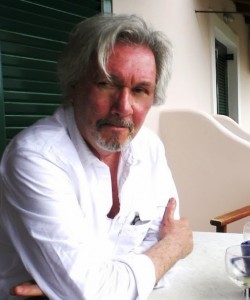
“I live in London which I love for its beauty, variety and cosmopolitanism. I count myself fortunate to have read anthropology at university; it is a study that gives you an insight into how societies work and combines very well with my historical imagination. Travelling is important; I do a fair amount of it. Travel is like reading books; I do both for the same reasons – discovery and learning.”
Michael Haag has written travel guides to Greece, Egypt, Lebanon and Syria, published by Cadogan Books and The American University in Cairo Press. He has also written Alexandria: City of Memory, about Constantine Cavafy, E M Forster and Lawrence Durrell in Alexandria, which was published by Yale University Press, and “The Templars: The History and the Myth: From Solomon’s Temple to the Freemasons” published in Britain by Profile Books and in America by Harper Collins. Michael recently returned to the inexhaustible topic of the Crusades with ” The Tragedy of the Templars: The Rise and Fall of the Crusader States.” In this special interview for the Knights Templar Vault, Michael Haag shares his perspective on the history of the Middle East and the Crusades.
Q. Michael, thank you for kindly agreeing to be interviewed for the Knights Templar Vault. It is pretty obvious that you have a strong interest in the history of the Middle East and the Crusades. How did this interest develop and at what point did you decide that among dozens of books about the Knights Templar there is room for at least a couple more and you should write them?
A. I love the Mediterranean; the warmth and the fragrance. I am especially attracted to the Eastern Mediterranean, warmer and more pungent; also it is very old, and I am fascinated by the multiple overlays of history – often expressed in the architecture of temples, churches, synagogues and mosques, sometimes built upon one another or growing out of one another. Syria, Lebanon, Israel, Egypt, all have their Mediterranean aspects and have shared in its history; all have their connections with other Mediterranean countries, Spain, France, Italy, Greece, Turkey and across North Africa. All have been part of the Roman Empire, and before that all the Eastern Mediterranean was part of the Hellenistic world. So for me the Middle East is part of something much larger in time and space.
My specific interest in the crusades was inspired by the young T E Lawrence when he was not yet ‘of Arabia’. In 1909, during the summer of his twenty-first birthday, he walked 1100 miles through Palestine and Syria, visiting scores of crusader castles. After reading of his journey and his descriptions of the castles, I decided to follow in his footsteps, or rather I cheated and I drove through much of Syria in a car.
You cannot visit castles like Krak, Safita, Margat and Saone without being amazed at the scale of the endeavour, the magnificence of their design and the beauty of the landscapes they survey. I knew the ancient sites of Greece and Egypt well; Syria, I discovered, not only has ancient sites but also wonderful castles, and to visit them is to awaken stories of battles and sieges and lonely mountain vigils. That is how my interest in the crusades began.
As for the Templars, they seemed a way into the complexity of the subject, the two hundred years of the crusader East – Outremer as it was known, the land across the sea, across the Mediterranean. The story of Outremer could focus on this elite force of a few hundred men. That is how many Templar knights there were at any one time, mounted and stationed in the East; very few, very brave, in a sense unconquerable because no sooner were they killed off than they were replaced. In the course of two hundred years at least twenty thousand Templars were killed, either on the battlefield or after being taken captive and refusing to renounce their faith to save their lives.
The Templars were the heroes of the age; they were celebrated in legend and song, admired and supported by laymen, clergy, kings and popes, as well as by the people they defended in the East, the pilgrims and the native townsmen and farmers. The whole tremendous effort from the eleventh to the thirteenth centuries to hold back the Muslim tide – which in effect was a massive migration of newly Islamised Turks from Central Asia – seemed to rest on the shoulders of the Templars. Their fate and the fate of Outremer – that land of native Christians bolstered by settlers from round the Mediterranean – were entwined; so that to tell the story of the Templars is a way of telling the story about everything.
I have been to the scenes of that story. Saladin’s Citadel in Cairo; the Temple Mount in Jerusalem; the fortified Cathedral of Our Lady at Tartus; the secret Templar tunnel beneath the streets of Acre; the Horns of Hattin in Galilee; and those wonderful castles everywhere, Christian and Muslim. Being there makes a difference – the past comes alive. I wanted to tell that story, the story of the Templars and Outremer.
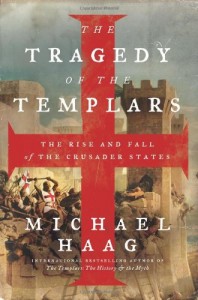 Q. When I first saw the cover of your new book The Tragedy of the Templars (the subtitle The Rise and Fall of the Crusader States somehow escaped my attention) I immediately assumed that having finished a book that covered the history of the Order in its entirety, you decided to turn to the final chapters of the Knights Templar history. But that was not the case at all! The book still deals with the entire span of the Order’s history, with more depth and possibly even with more passion. What was the background behind writing this project?
Q. When I first saw the cover of your new book The Tragedy of the Templars (the subtitle The Rise and Fall of the Crusader States somehow escaped my attention) I immediately assumed that having finished a book that covered the history of the Order in its entirety, you decided to turn to the final chapters of the Knights Templar history. But that was not the case at all! The book still deals with the entire span of the Order’s history, with more depth and possibly even with more passion. What was the background behind writing this project?
A. I was haunted by something written by the English traveller Henry Maundrell. Even four centuries after the fall of Acre in 1291, when the last Templars were driven from the coast of Outremer, the devastation wrought by the Mamelukes was still apparent. In 1697 Maundrell recorded the ‘many ruins of castles and houses, which testify that this country, however it be neglected at present, was once in the hands of a people that knew how to value it, and thought it worth the defending’.
The fall of the crusader states caused grief and anger in the West. The sins of the inhabitants of Outremer were blamed, as was the failure of the leaders of European Christendom to provide ample and timely aid, and the Templars were blamed too. No one was exempt. But it was the Templars who felt the loss most intensely. The defence of the Holy Land and the protection of pilgrims was their raison d’être. Now cast out from the Holy Land, the Templars found themselves vulnerable to the machinations and greed of the king of France. After seven long years of tortures, imprisonments and trials during which the Templars were humiliated, slandered and destroyed, and the last of the Templars, the grand master Jacques de Molay, was burnt alive at the stake.
But even worse was the fate of the native inhabitants of the East after the fall of Outremer. When the Templar fortress in Acre fell, it was the beginning of those scenes of devastation described by Maundrell, the devastation of their country and their lives. At the command of the Mameluke sultan al-Ashraf Khalil the survivors were led outside the walls where their heads were cut off and their city was smashed to pieces until almost nothing was left standing, a devastation that was repeated everywhere up and down the coast.
When Rudolph of Suchem came upon the spot forty years after Acre’s fall he found only a few peasants living amid the desolation of what had once been the splendid capital of Outremer. ‘Since that day’, he wrote, ‘all Christian women, whether gentle or simple, who dwell along the eastern shore [of the Mediterranean] dress in black garments of mourning and woe for the lost grandeur of Acre, even to this day’.
The testimony of Henry Maundrell and Rudolph of Suchem is a reminder that it was primarily the native inhabitants who suffered with the defeat of Outremer.
There are two serious misconceptions that people often hold about what we call the crusades (the term is a later invention and was not used at the time). The first is that the crusades were wars of aggression conducted by the West against the East. But that is the opposite of the truth.
In my book I have looked at the conditions in the East as they were before the crusades, at the circumstances of the beleaguered population – a population that remained overwhelmingly Christian 400 years after the Arab conquest. This Christian East had recently suffered a new invasion, this time by the recently Islamised Turks who in 1071 overran not only Palestine and Syria, but also Asia Minor, a vast and prosperous part of the Byzantine Empire, and soon stood on the Bosphorus opposite Constantinople, whose emperor called to his fellow Christians in the West for help.
These dangers and oppressions in the East understandably aroused a reaction in the West. In 1095 Pope Urban II called for the defence and liberation of the East, but neither the pope nor Christianity nor the West initiated the conflict. Rather, for centuries Islam had been on the attack. Already in the eighth century Muslim forces had occupied Spain; soon they invaded southern France, Sicily and the toe and heel of Italy; for a time they controlled the Alpine passes into Switzerland. In 846, a Muslim fleet even sailed up the River Tiber and sacked Rome. The crusades were part of a centuries-long struggle between Islam and Christianity throughout the Mediterranean world.
The second misconception is that the entire two centuries between the First Crusade which captured Jerusalem in 1099 and the end of Outremer when Acre fell in 1291 was all about fighting, and moreover was a continuous religious war of Christians against Muslims, and that meanwhile the Franks, the people from the West, lived insecure lives in walled towns and hardly mixed with the local population. This view is also wrong.
Most of the knights and other soldiers who made up the First Crusade very soon returned home to the West, but other people came East – farmers and artisans mostly, from southern Europe. This sort of migration was common round the Mediterranean as peoples’ ancient lands – in Spain, Sicily, southern Italy – were being liberated from Muslim occupation. To a farmer from Lombardy or a stone mason from Burgundy, settling in Palestine or Syria was little different from starting life anew in Languedoc or Catalonia.
They soon mixed with the local population, often living in the same villages, sharing the same churches, learning the local languages and reviving the old culture but with a new flavour. Intermarriage was common at all levels of society, so that it took no more than a generation for the ruling families of Outremer – the Kingdom of Jerusalem, the Principality of Antioch, and the Counties of Tripoli and Edessa – to become as much Eastern in descent as European. For two hundred years the lands of the Eastern Mediterranean were rejoined to the wider Mediterranean world. And thanks to support from the West, they enjoyed a prosperity, a freedom from discrimination, persecution and oppression, and a degree of self-rule they had not known since Byzantine times and were never to know again.
The Templars illustrate this peaceful situation. At first their role was primarily to patrol the roads, to escort pilgrims as they made their way from one holy site to another – there was a danger of brigandage from Arab bedouins but hardly more; as yet there were no battles to fight. The Templars also founded settlements and helped develop the rural economy by building roads and bridges, watermills and granaries, and by establishing glassworks in the countryside.
Local Muslims were likewise the beneficiaries of the settled conditions enjoyed by Outremer. Ibn Jubayr, a Spanish Muslim who had been on a pilgrimage to Mecca, wrote of his journey through Outremer in 1184 as he travelled between Damascus and Acre: ‘The Muslims here own their own houses and rule themselves in their own way. This is the way the farms and big villages are organised in Frankish territory. Many Muslims are sorely tempted to settle here when they see the far from comfortable conditions in which their brethren live in the districts under Muslim rule. Unfortunately for the Muslims, they have always reason for complaint about the injustices of their chiefs in the lands governed by their co-religionists, whereas they can have nothing but praise for the conduct of the Franks, whose justice they can always rely on’.
Ibn Jubayr’s account is all the more striking as he was otherwise resolutely opposed to the Franks. But he could not deny the respect with which the Franks treated his fellow Muslims. In Acre itself he discovered that, though two mosques had been converted to churches, Muslims were nevertheless free to use them as meeting places and to pray in them, facing towards Mecca. There was nothing unusual about this; the Arab diplomat Usamah ibn Munqidh mentions in his memoirs the hospitality he received from the Templars who welcomed him to pray in their chapel within their headquarters on Jerusalem’s Temple Mount.
All this changed however when Saladin began his jihad. Then the period of warfare and castles began. From then on the fate of Outremer depended largely on the courage and resolve and the fighting qualities of the Templars. And so my book does not confine itself only to the last years of the Templars. To understand why the fall of the Templars mattered, and what was lost when the Templars fell, it is necessary to understand the land and the civilisation they fought to defend.
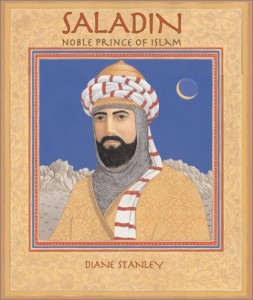 Q. I have a quote that I would like you to comment on. It is from a book by Diane Stanley, entitled Saladin: Noble Prince of Islam. It actually appears on reading lists at some American public middle schools.
Q. I have a quote that I would like you to comment on. It is from a book by Diane Stanley, entitled Saladin: Noble Prince of Islam. It actually appears on reading lists at some American public middle schools.
“One day this boy [Saladin] heard a dreadful story. Forty years before he was born, his country had suddenly been invaded by thousands of Franks, fierce barbarians from the West. They were Christians, and because the land was holy to them, they thought it should be theirs. So they rode in with their swords and lances and conquered one Muslim city after another. Then they turned inland and, in 1099, they took the Holy City of Jerusalem, murdering everyone who lived there – Muslims, Jews, and even Christians.”
I understand that it is unfair to judge a book based on a single quote, but are there any general thoughts that occur to you after reading this?
A. I gather that Diane Stanley writes and illustrates books for young people and I suppose she wants everyone to hold hands and be nice. But that is no excuse for her profound ignorance and general silliness.
She describes the Franks as alien barbarians conquering Muslim cities. But the outsiders were the Arabs and they were also oppressors who ruled over what was still at that time a majority native Christian population with, in Palestine, a significant Jewish minority – an oppression marked in numerous ways, including imposing discriminatory taxes on Christians and Jews, refusing permission to repair or rebuild churches and synagogues, forbidding them to ride horses or mules, forcing them to wear distinctive clothing, and not admitting their testimony against a Muslim in a court of law.
Think for example of Arab rule in Spain and Portugal which lasted nearly eight hundred years, almost twice as long as Arab rule had lasted in the Middle East by the time of the First Crusade. Does Diane Stanley think that it was wrong to fight against the Arab occupation of the Iberian peninsula? Is it wrong that Barcelona and Madrid and Lisbon today are not garrisoned by Muslim armies? She ought to write and illustrate a book about that.
And by the way, when the Franks finally took Jerusalem in 1099 they did not, as Stanley says, murder everyone who lived in the city, whether Muslim, Jew or Christian. By the conventions of the time, a city that did not surrender was subject to the death or slavery of its inhabitants. The Franks met long and stout resistance before they stormed Jerusalem, and when they did so they killed three thousand people, according to an informed Arab source. I am not defending what happened, but it was not ‘murdering everyone who lived there’. Twenty-two years earlier in 1077 when the Turks laid siege to Jerusalem and the city agreed terms and freely opened its gates – which meant that the lives and liberty of everyone should be spared – the Turks nevertheless murdered three thousand of its inhabitants in cold blood. But Stanley says nothing about that.
Saladin was a Kurd but he was not born in Kurdistan, instead he was born in about 1138 in Tikrit in Iraq where his father was appointed governor by the Turkish Seljuk sultan. Tikrit had once been an important Christian city just as Iraq had been a major centre of Christianity – as important a centre of Christianity as Constantinople and Rome; but then the Arabs invaded Iraq and were followed by the conquering Turks.
In that sense the story of Iraq is similar to that of many other places in the Middle East – the native Christian population was imposed upon by Muslim Arabs who in turn were imposed upon by Muslim Turks.
So Saladin was a Kurd, a Turkified Kurd, born in Iraq, which was not his native land; nor was Iraq ever invaded by crusaders. Maybe Diane Stanley was thinking of Syria when she wrote of ‘his country’; Saladin spent his boyhood in Lebanon and Syria where Saladin’s father was employed to seize the country from rival Turks who had seized it from the Arabs who had seized it from the native Christians who were still the majority of the population. Or maybe when she wrote ‘his country’ she was thinking of Egypt which Saladin invaded and where he overturned an Arab regime which ruled over a Christian majority population.
Saladin was not much interested in Christians or crusaders; in the fifteen years of his military career leading up to his capture of Jerusalem in 1187 he spent no more than thirteen months fighting the Franks; the other fourteen years were spent fighting fellow Muslims, both Arabs and Turks.
In this his purpose was two-fold. Saladin, like the Turks and Kurds generally, was a Sunni Muslim whose religious leader, the caliph, was at Baghdad, but Egypt at the time was in the hands of the Fatimids who were Shia Muslims who had their own caliph at Cairo. These were the two great centres of the Muslim world, each at the heart of a Muslim empire – and they were deadly rivals. The Shia and the Sunni each saw the other as heretics, and each wanted to eliminate the other and make themselves masters of the world. For Saladin war against the Shia mattered far more than war against Christians who, after all, were not a threat to Islam nor to Islamic orthodoxy.
Saladin’s second purpose – many Muslims at the time said it was his primary purpose – had less to do with religion than with power; he wanted to become supreme ruler and to establish a dynasty for himself. Saladin’s suzerain, the caliph at Baghdad, was fully aware of this; when Saladin captured Jerusalem, the caliph, who had been relying on the Franks to keep Saladin in check, remarked, ‘This man thinks that he will overturn [my] dynasty’.
The period bracketed by the crusades can be better understood as a renewed outbreak of the latent civil war between Sunni and Shia Muslims which began in the earliest years of Islam and continues to this day.
Diane Stanley writes of Saladin learning as a boy that ‘his country’ had ‘suddenly been invaded’ by ‘fierce barbarians from the West’. But the crusades were no invasion; they were a response to a plea for help from the Christians of Jerusalem and the Christian emperor of the Byzantine Empire after the Turks had invaded Asia Minor and the Middle East, causing destruction wherever they went, and threatening to cross the Bosphorus, capture Constantinople, and overrun Europe itself. But no one ever invited the Arabs or the Turks to invade and occupy the Middle East.
Saladin would not have talked of ‘his country’ or been recognised as one of themselves by the majority Christians or the minority Arab Muslims of the Middle East. Neither the Syrians nor the Egyptians spoke Turkish, which was Saladin’s language of command. His army was overwhelmingly Turkish; his personal bodyguard was an elite corps of Turkish Mameluke slave soldiers. As the Cambridge History of Islam states, Saladin’s army was an ‘alien’ army among the peoples of the Middle East. ‘Himself a Kurd, he established a regime and an army of the Turkish type’.
Without depreciating Saladin’s personal qualities for which the Franks rightly admired him, it is nevertheless fair to say that in capturing Egypt, and in all his wars against the Muslims of Syria and the Franks of Outremer, Saladin was not a liberator; he was an alien leading an alien army of conquest and occupation – imposing himself on the majority native Christian population as well as usurping the position of their Arab oppressors who bitterly resisted his ambitions.
Q. What part of Templar mythology would you be most excited to see suddenly pick up and move into mainstream history, due to some newly discovered solid evidence?
A. The head. The evidence that the Templars used a head in their rituals is uncertain and anyway there are various explanations of what it was all about. The discovery of a head would be interesting – complete with an instruction booklet explaining how to use it, worship it, keep it fresh, and above all giving its name. Baphomet or what?
Q. Do you have any favorite Templars?
A. Very few Templars come through clearly enough in the records to sense anything about them as individuals. The main exception is Jacques de Molay, the last grand master. And I cannot say that I find him very inspiring; an earnest man but a bit of a political bumbler. Still, I admire his belief in and loyalty to his order, his insistence on its fundamental decency and worth, and the remarkable integrity, dignity and courage he showed in choosing to go to his death in the flames rather than put up with the crap the king of France was throwing at him.
Q. Not to dwell too much on the title of your book, but tragedy, in a traditional sense, requires catharsis. There has to be a profound redeeming experience, something that transcends pain, disillusion and even death, something that offers promise and hope. What can we glean from the Templars’ story that would hold value in our own predicaments?
A. The Templars met a miserable end. It was a calamity for them. But was it ever anything more? Were they merely a band of men fighting for a narrow cause whose time was up?
In fact at the western end of the Mediterranean, in the Iberian peninsula, where the recovery of lands from the Arabs was meeting with success, the Templars were valued and continued under a change of name. At the eastern end of the Mediterranean where the home of Christianity was overwhelmed by the massive Turkish invasion from Central Asia the war of recovery failed – and the Templars became the victims and scapegoats of that defeat.
The age was a religious one and many may have marched in the name of God. But the indigenous Christians of the East were not marching anywhere; the East was their home. After the First Crusade they were joined by settlers from elsewhere in the Mediterranean and revived their old culture that had been suppressed under centuries of Muslim occupation. These were the people of Outremer, the generations of men and women who worked the land, built houses and churches and roads, and whose shattered lives were remembered by Maundrell when he wrote that the ruined country through which he was passing was ‘once in the hands of a people that knew how to value it, and thought it worth the defending’.
The Templars were among those who thought the land was worth the defending.
I see many parallels between the present and the past in the Middle East; pick up a newspaper and you read about the same sorts of destructive causes fighting in the same places, rather than a cherishing of the land.
I am not sure that there is anything cathartic in the story. There is learning and understanding, however. It is better to recognise things for what they are, rather than believe that they are about something they are not.
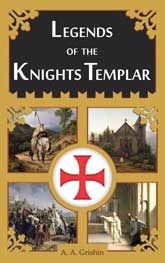
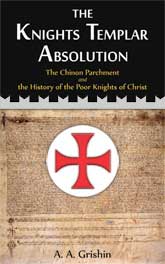
1 comment… add one
Superb interview , & Quality questions . This fuels my passion for The Templar period of history . I would love to know more about “individual” accounts of Templar Knights acts in the Middle east . A fascinating period of history . Thanks for sharing it .